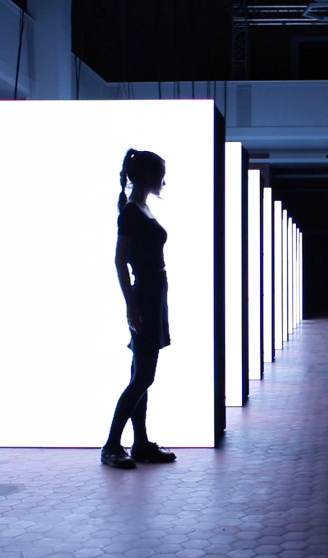
Nonotak Studio
_COLLAPSE V.1
Nieuwe audiovisuele installatie gepresenteerd in Nizhny Novgorod, Rusland voor Intervals Festival 2021.

_COLLAPSE V.1
Nieuwe audiovisuele installatie gepresenteerd in Nizhny Novgorod, Rusland voor Intervals Festival 2021.

AI-DA
Ai-Da est le premier artiste ultra-réaliste au monde. Elle dessine en utilisant des caméras dans ses yeux, ses algorithmes d’IA et son bras robotique. Créée en février 2019, elle a eu sa première exposition solo à l’Université d’Oxford, « Unsecured Futures », où son art a encouragé les téléspectateurs à réfléchir à notre monde en évolution rapide. Depuis, elle a voyagé et exposé des œuvres à l’échelle internationale, et a eu sa première exposition dans un grand musée, le Design Museum, en 2021. Elle continue de créer de l’art qui remet en question nos notions de créativité dans une ère post-humaniste.

Sonic Mountain
As a unique site-specific commission for the Donum Estate, Los Angeles-based artist Doug Aitken has created the ethereal work Sonic Mountain (Sonoma), three concentric circles of suspended stainless-steel pipes whose differing lengths form a wave at their base, mirroring the free Euler-Bernoulli shape that describes the chime’s frequency. Installed in the eucalyptus grove, measuring forty-five feet in diameter and twice human height, and comprising 365 chimes — one for each day of the year — Sonic Mountain (Sonoma) works with one of Donum’s most persistent elements, the Carneros breeze that cools the grapes and creates a temperate zone for growing Pinot Noir. Each day, the warm wind begins its soft whisper, rustling through the vines and trees, building in strength through the day until mid-afternoon, and then gradually diminishing in force. Known to have been used since at least the ancient Roman period in Europe and the second century in India and China, wind chimes create chance, inharmonic music. At Donum, Aitken has teamed up with his friend the composer Terry Riley to compose chords in the chimes to be played by the wind , depending on how it blows, so the lyrical work sounds throughout the estate, demonstrating the artist’s practice of making installations that synthesize many media and are never constrained by tradition.
video

Cloud Face
Humans see figures in clouds: animals, faces and even god. This kind of perception also appears in machine vision. Face-detection algorithms sometimes find faces where there are not any.’Cloud Face’ is a collection of cloud images that are recognized as human faces by a face-detection algorithm. It is a result of machine vision’s error but they often look like faces to human eyes too. Humans, yet, know these are not actual faces. Humans rather imagine faces from the clouds. Here, the error of machines and the imagination of humans meet.

“Arrival’s narrative plays out in four languages: English, Mandarin, Russian and Heptapod. Though they are not spoken in the film, we learn that Louise is also fluent in Farsi, Sanskrit and Portuguese (and possibly others). The language learning process and the growing translingual bond between Louise and the heptapods forms the film’s narrative arc and the majority of its plot. Thus language, and specifically the mechanics of ←215 | 216→multilingualism, is Arrival’s central theme. Within this context, the ability to communicate across language barriers is an asset, and the flexibility to navigate new linguistic challenges is invaluable. The heptapods are pure science fiction, but serve a powerful metaphorical function. As Emily Alder (2016) writes in The Conversation, “ultimately, Arrival is less about communicating with the aliens than with each other – internationally but also individually […] The film’s message is that difference is not about body shape or colour but language, culture and ways of thinking. It’s not about erasing that difference but communicating through it”. Gemma King
.
语言学习过程以及路易丝与七足动物之间越来越多的跨语言联系形成了电影的叙事弧线和大部分情节。 因此,语言,尤其是←215的机制| 216→使用多种语言是到达中心的主题
.
Процесс изучения языка и растущая межъязыковая связь между Луизой и гептаподами составляют повествовательную дугу фильма и большую часть его сюжета. Таким образом, язык и, в частности, механика ← 215 | 216 → многоязычие – центральная тема Арривала.

Compression de densité
Avec Density Compression [2020], Fujimoto tourne son attention vers les comportements fondamentaux de la lumière visible, en se concentrant sur les lignes droites et la réflexion. En représentant la lumière comme un réseau dense de lignes voyageant dans un espace limité, l’artiste rend la lumière comme un objet physique, lui permettant d’explorer et finalement de changer son comportement de base. La pièce est accompagnée d’une partition atmosphérique du compositeur expérimental et affilié de Raster-Noton Kyoka.

“Poem for an artificial intelligence”
the sun is a beautiful thing
in silence is drawn
between the trees
only the beginning of light
this realm of rain
grey sky and cloud
it’s quite and peaceful
safe allowed
And, arguably, worse:
I am a coal-truck
by a broken heart
I have no sound
the sound of my heart

The coffee cup spring
The monotone repetition of the movement created by the conveyor belt recalls the pace and the landscape of animation or video games. As an extension of the conveyor, several geometric and orthogonal motifs evoking a Tetris composition are slotted together and suggest the shapes of a table, a chair or stairs. The objects are exposed on thin metal structures with fringed ends, and seem to peel off from their construction, as if they were undressing and exchanging skins, depriving themselves of sculptural depth and allowing only the surface to emerge. The technique developed by the artist to produce the sculptures inverts the usual steps of printing: first the pattern is created, then the background to which the fiberglass support is apposed. The pieces are therefore ripped off their mold, revealing their final texture, and the motif on every sculpture seems to remain the same, yet is altered by the shape of the object itself. A series of wall works using this procedure extends from the installation into the gallery space.
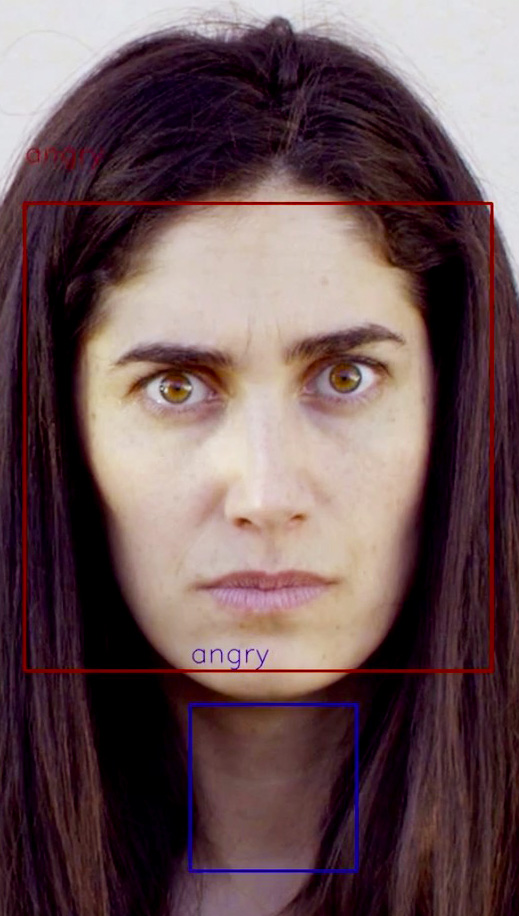
Princess of Parallelograms
What will happen when our imagination itself is externalized in machines? Artificial intelligence constructs its own world-truth that is beyond our sensory perception. Generative Adversarial Networks (GANs) use algorithms to synthesize and generate images in a completely new way. These images have almost uncanny aesthetic characteristics, seeming to emerge from an ocean of data, a kind of pixel soup. Rather as if we were observing the emergence of artificial “thought.” The machine learns to understand the “essence” of a thing, be it an animal, the face of a celebrity or a body of text. It is then able to generate new images of this thing, including faces of celebrities who do not exist, mutant animals, or new texts. Eventually, AI will be capable of instantaneously and dynamically emulating all representations. The era of the optical machine and the capture of reality will then be at an end, supplanted by the era of machines that generate their own reality.

Structures infinies
Between the finite and the infinite, these mirror structures are reflecting the outside world until they are set in motion to unveil a moving and infinite interior. Hidden inside are superimposed diagrams reinterpreting certain theories or hypotheses related to our apprehension of the world. Between transcendental geometry, higher dimensions, finite and infinite, these structures arise as objects of reflection on what one understands, what one believes to understand and what one does not understand. The structure is thus referring to the finite physical structure that is encapsulating the infinity of intellectual structures created by the humankind.

Roots of rebirth
During such rarefied times, the designer explores a symbiosis of high technology and the artisanal craftsmanship of couture, through a collection that references the intricacy of fungi and the entanglement of life that breathes beneath our feet. Through ‘Roots of Rebirth’, Van Herpen notions towards the miraculous lacery of interconnectedness from the natural ‘wood wide web,’ weaving a dialogue between the terrestrial and the underworld. ‘Roots of Rebirth’ extends its own branch, an invitation to a sequence of 21 looks inspired by roots and spores. During the show, the models seem to magnetise a living lace of spores with each stride, the entanglement of each garment resembles roots of regeneration.

Terraforming
The video work “terraforming” focusses on the transformation of a natural environment through energy input. The underpinning idea is that of three phase system change. This begins with the stage of equilibrium where a system is in a certain balance and not changing at all. In the next stage an evolving system enters a state of motion and change where it moves away from equilibrium. The third and final stage is the phase of transformation in which the original system becomes something else. The key element in this transformation process is the sun. This process is called terraforming, whereby a hostile environment, i.e. a planet that is too cold, too hot, or has an unbreathable atmosphere, can be altered to make it suitable for human life. Such a process is not merely a futuristic scenario but represents exactly what is happening on Earth at this moment as the process of atmospheric change brought about by increasing CO2 emissions heats up our planet and speeds up the process of climate change.
video
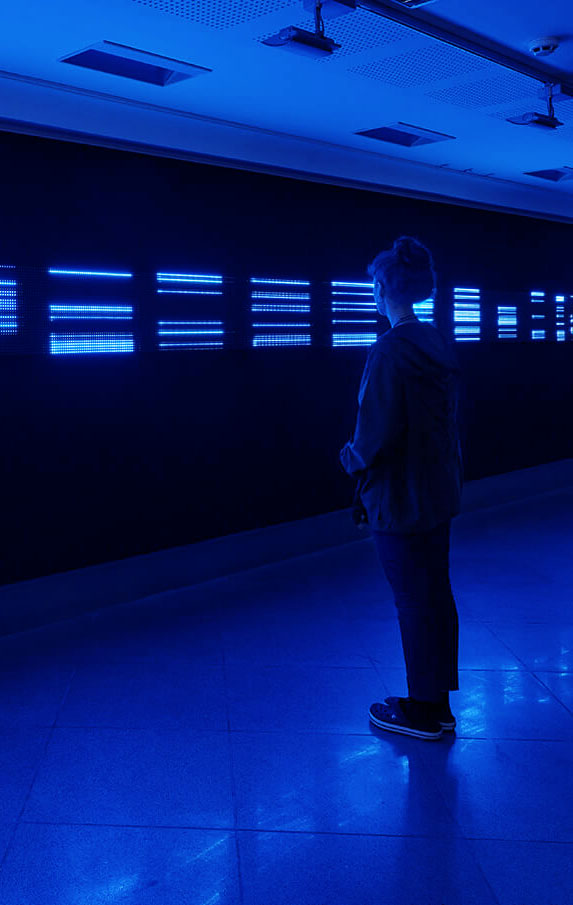
In-line
Nohlab’s audiovisual installation in-line was inspired by the natural phenomenon of horizon, and used a total of 21 LED panels, reflective surfaces on two ends, hazer and a quadraphonic sound system to turn the limited area into a limitless space and present an everchanging time-space experience […]The installation takes its form not only from the content, but also from the space it is exhibited. Its audio and video elements are especially designed for a holistic perception of sound and visuals, letting the audience live a synesthetic experience. This way, the audience steps into a different reality than the one they are already in.

sensory seas
runway LOOK 08
“The first threads of inspiration came from the Spanish neuroanatomist Ramón y Cajal. He wanted to uncover something that no one had yet understood.
Sensory seas’ holds a microscope over the indelible nuances between the anthropology of a marine organism, to the role of dendrites and synapses delivering infinite signals throughout our bodies. It enchants the attention of how two processes of torrential messaging exist in an uninterrupted state of flux. The collection consists 21 silhouettes that illustrate a portrait of liquid labyrinths, where dresses spill onto the floor in elegant train and pigments gather in cloudedpools of blues and lilac, leaking into one another like marble.” Joanna Klein

a far cry
concerto grosso no 1
V. Rondo: Agitato
Alfred Schnittke’s haunting first Concerto Grosso for 2 violins, harpsichord, prepared piano and 21 strings,
violinists; Nelson Lee & Meg Freivoge
harpsichord & prepared piano: Andrus Madsen
.
“It’s a piece by Alfred Schnittke, a Russian polystylist composer who spent most of his life behind the Iron Curtain. Schnittke is underrated. This is perhaps due to his post-modern tendencies, which for lesser composers can be a veil for lack of substance. That’s not the case in this piece. Take a listen to the fifth movement of his Concerto Grosso No. 1 (1977). It is a great example of how Schnittke freely takes from disparate styles to create an unpredictably effective result”. David Werfelmann

לינדר סטרלינג
ЛИНДЕР СТЕРЛИНГОВ
The bodies, objects and surfaces were recognisably 21st century, but details and composition seemed oddly out of time, not least because the imagery was excised from print magazines and not from the internet, but also because the completed works so readily recalled Linder’s first photomontage experiments. Her pairings of different types of consumerist desire, which once declared themselves as critiques of misogynist objetification, are now equally a part of an abiding artistic practice. For example, looking at a particular conjunction of mock-ecstatic porn performers and ornate confectionery, we get the “message” but know too that we can only be in the obsessive, repetitive world of Linderland.
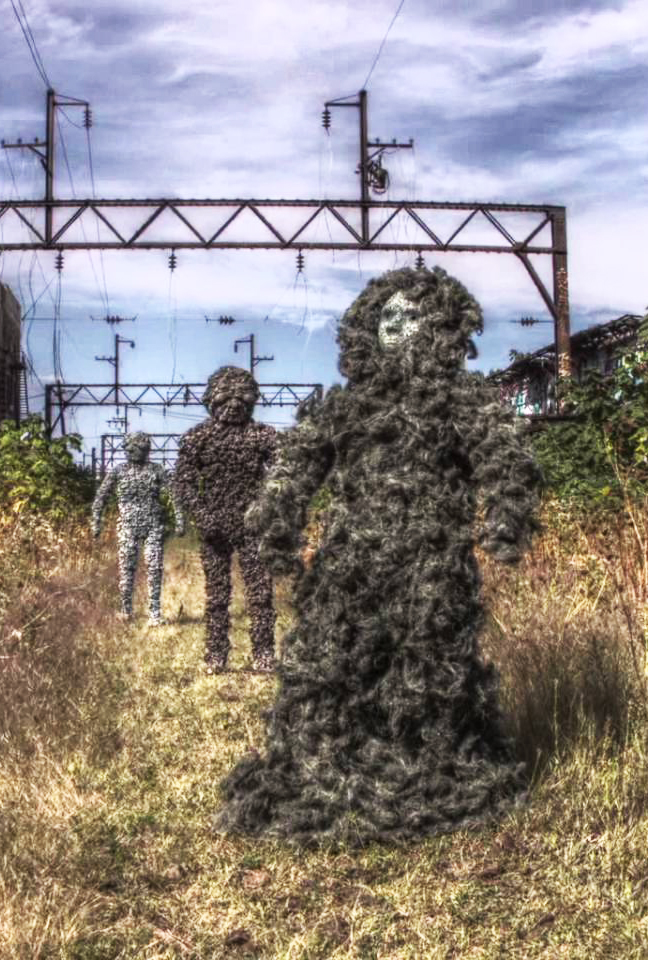
Craco
Tobias Stretch channels the beauty and melancholia of Hauschka’s single “Craco” in his uncanny video filmed in Philadelphia’s answer to Brooklyn’s High Line, Reading Viaduct Park. With music videos for Radiohead, Crystal Fighters and Christopher Bono to his name, the Philly-based animator is known for his distinct aesthetic and method, pairing landscape photography with life-size stop-motion puppets. “I thought right from the beginning when I saw Tobias’s work that it has a mixture of analog and handmade elements and a surreal atmosphere. In my music you have similar elements,” says Hauschka himself, aka the German pianist and composer Volker Bertelmann, who headline’s London’s Union Chapel tonight as part of his European tour. Although best known as a 21st-Century protagonist of the prepared piano practice championed by John Cage, Bertelmann “left all the preparations at home” in order to work with a pure sound on this track. Named after the Italian ghost town, “Craco” is taken from his entropy-laced album Abandoned City and played to Stretch’s own fascination with urban decay. “The music was there beforehand, but I had a bowl of music and a bowl of names and I tried to pair them up. I think the music sounded not only like an abandoned place but also like a nostalgic place and that’s why I thought it was a great match.”
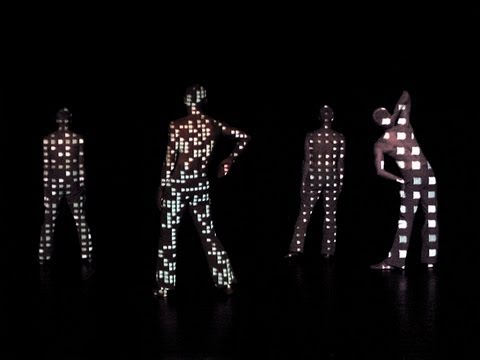
Vivisector
o what extent does the quality of movement of the virtual world influence real sequences of human movement? Will the real world of the 21st century assume via nanotechnology attributes of the virtual world? Are there still significant differences between a body that is made of synthetic material and warmed artificially and the deep glow of trillions of living cells? VIVISECTOR is an examination of the different speeds of people/nature and technology/information society and of their acceleration; an experiment to overcome the space-time continuum in the real world. It breaks the linearity of movement and in doing so shows the absurdity of momentum. Based on the video-technological concept of the moving body-projection that made D.A.V.E. an international hit, VIVISECTOR now goes one step further: the exclusive concentration on video light and video projection produces a new stage aesthetic in which light, body, video and acoustic space form an unprecedented unity.